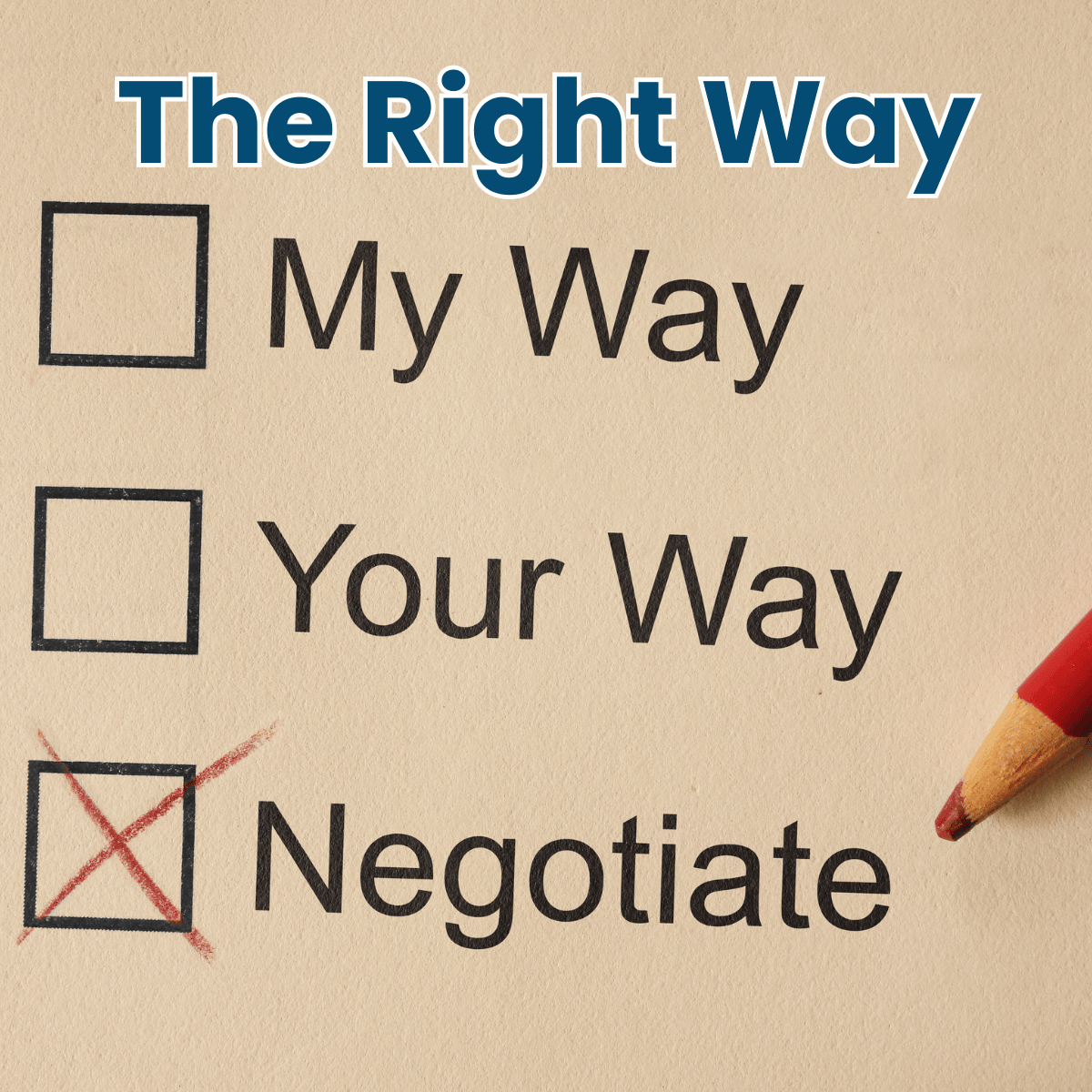- CONNECT collective
- Posts
- The Art of Quiet Negotiation: Don't Sacrifice Your Work's Value
The Art of Quiet Negotiation: Don't Sacrifice Your Work's Value

The Power of Quiet Negotiation
Do you regularly feel stuck in client negotiations? And do you often wind up undervaluing your services, and open the door for scope creep or cash flow issues to take over?
This is a common issue among solopreneurs and small business owners. Client acquisition is a big part of any small business, so it’s easy to allow fear of losing a client, customer, or deal to control your decision making process.
You may feel pressured to offer services or products that are fast, good, and cheap. But, logically, that’s not how a successful business runs.
Negotiation is a skill that you can develop. Today, we’re discussing quiet negotiating. It’s a low-pressure, collaborative approach to secure better terms (e.g., phased payments, scope adjustments) without confrontation and anxiety.
We’ll walk through a simple, repeatable framework to negotiate confidently, improve client acquisition, and maintain positive relationships.
Success starts with a mindset shift—viewing negotiation as collaboration, not conflict.
Why Negotiation Feels Hard
Negotiating a contract, proposal, or pricing of a package can induce anxiety in the most seasoned of business owners.
Oftentimes, this nebulous anxiety is rooted in tangible and straightforward pain points:
Fear of Rejection: Solopreneurs worry that asking for better terms will scare clients away.
Undervaluing Services: Many accept lower rates or vague scopes to secure work, leading to burnout or financial strain.
Lack of Process: Without a clear negotiation strategy, discussions feel awkward or unproductive.
Client Acquisition Struggle: Inconsistent client pipelines make solopreneurs feel desperate, weakening their negotiating position.
There are also Mindset Barriers:
Viewing negotiation as adversarial rather than collaborative.
Imposter syndrome or fear of seeming "greedy."
Lack of confidence in articulating value.
Which of these sounds like barriers you’re encountering? If you can identify it, you can fix it.
And fix it you must!
The consequences of not addressing your blocks when it comes to negotiations can quickly lead to accepting bad terms leads to overwork, resentment, and unstable cash flow, which hurts long-term business growth.

Reframing Negotiation as Collaboration
Your mindset is the most important ingredient in your success. Adopt the mindset principles listed below to shift your beliefs around negotiating.
Key Mindset Principles:
Negotiation is Problem-Solving: Approach discussions as a way to create win-win outcomes, not a battle.
You’re an Equal Partner: Clients need your expertise as much as you need their business. Own. Your. Value.
Clarity Breeds Confidence: Knowing your worth and desired terms upfront reduces anxiety.
Abundance Mindset: Trust that saying "no" to bad terms opens doors to better clients.
Practical Mindset Exercises:
Write down your unique value proposition (e.g., what makes your service indispensable?).
Practice reframing asks (e.g., instead of “Can you pay more?” say, “Let’s explore a structure that aligns with your goals and my expertise.”).
Visualize successful negotiations to build confidence before client calls.
With the right mindset, you’re ready to follow a simple framework to negotiate effectively.
The Quiet Negotiation Framework: A 5-Step Process
The following framework is a simple, repeatable, low-pressure negotiation process that guarantees better terms without friction or anxiety.
Steps:
1. Prepare with Clarity:
When preparing a proposal, research your client’s needs, budget, and goals (use their website, X posts, or prior communication).
Define your non-negotiables (e.g., minimum rate, phased payment schedule, or scope boundaries).
Prepare 2–3 flexible options (e.g., tiered pricing or deliverables) to offer during the discussion.
2. Set the Tone Collaboratively:
Start the conversation with empathy: “I’m excited to help you achieve your goals. Let’s find a structure that works for both of us.”
Ask open-ended questions: “What’s your timeline?” or “How do you envision this project unfolding?”
Build trust by showing you understand their needs.
3. Present Terms as Solutions:
Frame your proposal as a solution: “To ensure quality and alignment, I suggest breaking the project into phases with payments at key milestones.”
Highlight benefits: “This keeps cash flow manageable for you and allows us to adjust scope, as needed.”
Use “we” language to reinforce partnership.
4. Handle Objections with Curiosity:
If the client pushes back (e.g., “That’s too expensive”), respond with questions: “Can you share what you had in mind?” or “What’s driving your budget concerns?”
Offer alternatives (e.g., reduced scope for lower cost) without compromising your non-negotiables. A tip from Chris Do is to say, “It sounds like we want to work together, but I understand that my initial proposal doesn’t meet your projected budget. I can offer ______ (alternative) for the budget you have allotted.”
Stay calm and avoid defensiveness.
5. Seal the Deal with Confidence:
Summarize agreed terms: “So, we’ll proceed with _____ (specifics)—sound good?” It may be overkill, but I like to state the terms verbally and include them in an email that I send immediately after meeting with the client. Then, I do the next step.
Send a clear contract or proposal immediately to lock in terms.
Follow up promptly to maintain momentum.
Putting the Framework into Action
Let’s put this framework into action around a real-world scenario: A freelance designer negotiating with a startup for a website redesign.
Application of the 5-Step Framework:
The designer prepares by researching the client’s brand and budget constraints.
She then proposes a phased payment plan (e.g., 30% upfront, 30% at wireframes, 40% at launch).
Next, she frames scope adjustments as flexibility: “We can start with core pages and add features later.”
The designer handles budget objections by offering a smaller initial phase.
Finally, she secures a signed contract with clear milestones.
Result: The designer secures fair pay, avoids scope creep, and builds a long-term client relationship.
My Final Word: Start Negotiating Quietly Today
Quiet negotiation combines mindset (collaboration, confidence) with a simple 5-step framework to secure better terms without friction.
Now, it’s your turn: Apply the framework in your next client conversation. Practice one mindset exercise this week to build confidence. The more you put these new skills into action, the more confident you will become at negotiating terms that are fair for your clients and you.
Consistent, quiet negotiations lead to sustainable client acquisition and business growth.
Join CONNECT-collective on YouTube and LinkedIn!
I would love to have you as part of the CONNECT-collective community on our other platforms. If you are a solopreneur or entertaining starting your own solo business, I invite you to check out CONNECT-collective on YouTube!\ and LinkedIn! I talk about starting solo businesses to escape your 9-5 while avoiding burnout. I would love to see you there!
Have a Question or Want to Suggest a Topic?
I am here for you. If you have a question, want to suggest a topic, or just want to say, “Hello!” I would love to hear from you. Send me an email at [email protected]
Sending you all Peace, Love, & Harmony!
-Michele

Do You Need Help Tapping Into Your Potential?
Are you struggling to meet your goals and wish you had support? Have you ever considered working with a coach? You may not know what a coach does.
One-on-One Coaching:
You and I develop an individualized plan targeting your specific goals
You receive individualized support from me
Answers to your specific questions
Guidance on your specific issues and blocks
Accessibility to me outside coaching sessions for added support (individual texts and emails to check in)
Your plan leads to learning how your personal growth is in your control
Are you ready to take action but are at a loss on what step to take next?
I can teach you how to get started and accelerate your growth by using repeatable methods. Need the tools? I’ve got them. The goal is always to make you independent. I should be working myself out of a job. Once you take off, you may want to have a session from time to time, especially if you are scaling your goals. A good coach teaches you how to stand on your own two feet. Contact me today ([email protected]). Are you ready to CONNECT?